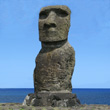North of the Tahai Complex there are no motorways. The terrain is difficult, and can only be passed on foot, by mountain bike, or very special on horseback. To find the caves near the coast you actually need a guide, because there are little to no signs to point you in the right direction. More inland you can find the only 7 Moai overlooking the sea. Also inland but nearer Hanga Roa is a scoria quarry where the red Pukao head ornaments originated from.
Hanga Kio’e:
The complex consists of 3 Ahu with Moai, of which 2 are unnamed but are restored, as well as Ahu Akapu which is still a ruin. Ahu Hanga Kio’e lies north of Akapu. The 2 restored Ahu date from somewhere in the 17th century and together with the Tahai complex, they form a good indication how a village from that period must have looked like. Both Ahu have a Moai, with 1 in pretty good state, and the other one headless. It is said that each new Ariki, or King, lived Hanga Kio’e for a while.
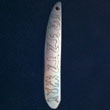 Rongorongo:
Rongorongo:
Around Hanga Kio’e was the school where one could learn the art of Rongorongo engraving. Rongorongo is scripture, that was only engraved on wooden tablets, and consists of images that depict animals and possibly humans. It is unclear whether these inscriptions contain an alphabet, if it is syllabary, or a scripture based on hieroglyphics. One suspects that the images are ritual songs, prayers or myths, but so far, people have been unable to decipher the Rongorongo writing.
Tip: If you are looking for a souvenir, in Hanga Roa you can find wooden tablets, or engraved pendants with the Rongorongo script.
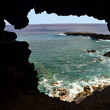 Ana Kakenga – La Cueva de las dos ventanas:
Ana Kakenga – La Cueva de las dos ventanas:
In the middle of a field strewn with rocks, there is a hole in the ground which is the entrance to a 50 metre long lava tunnel. At the end, the cave plits in 2, giving it the appearance of 2 windows with magnificant views over the sea. From Ana Kakenga, also known as the cave of the 2 Windows, you have a magnificent view over the sea. The cave probably served as hiding place against possible slave drivers, or rival tribes. Ana in Rapa Nui means cave.
Tip: Don’t forget to bring a head light!
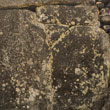 Ahu Tepeu:
Ahu Tepeu:
Ahu Tepeu is an important archaeological site with regards to the prehistoric community of the island. The base of the Ahu and the fallen Moai of are very similar to Ahu Vinapu where the boulders tightly fit together. The restoration attempt in 1960, has done more harm than good unfortunately. A little further on are the foundations of Hare Paenga, boat houses, Hare Moa, chicken pens, and Manavai, walled gardens.
.
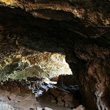 Ana Te Pahu:
Ana Te Pahu:
Ana To Pahu, is a cave complex with multiple underground tunnels a couple of hundred metres long and the largest underground tunnel system of Chile. Several plantations will grant access to the caves. The lava tunnel where you can normally stand up straight is moist and dark, and a large part of the caves are actually under water.
.
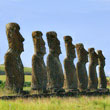 Ahu Akivi:
Ahu Akivi:
A little northeast of the volcano Vaka Kipo, is an Ahu with 7 Moai. What makes Ahu Akivi so special is that this 33 metre long Ahu is inland, and that the 7 Moai are facing towards the sea. This has probably some astronomical meaning, because this Ahu is positioned in such a fshion, that twice a year the Moai are facing exactly into the sunset; during the spring and autumn equinox, the day that the Sun stands perpendicular above the equator, which marks the beginning of spring or autumn.
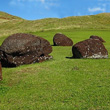 Puna Pau:
Puna Pau:
Puna Pau was the scoria quarry on Easter Island and is part of the Terevaka massif. Scoria is a volcanic rock with multiple holes or blisters, and can have different colours, such as dark brown, black and even red. The Puna Pau quarry was the place where mainly the red Pukao, head ornament, was made, to be placed upon the Moai at a later stage. It is believed that the development of the scoria started only at a later stage, because not all Moai support Pukao, and there 25 Pukao at the Puna Pau quarry, ready to be transported . Also, both the Tukuturi Moai at Rano Raraku, the female Moai at Vinapu and some petroglyphs are created scoria scoria of Puna Pau quarry.
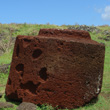 Pukao:
Pukao:
There are several theories what exactly a Pukao may be. In any case, it is a head ornament, that possibly could represent a hat. Some believe it’s a feather headdress, but it could also represent a tied hair knot. An average Pukao is about 2, 4 m tall and has a diameter of about 1.5 m, ranging in weight between 5 and 12 tonnes. Some Pukao are decorated with petroglyfs.
.
.


